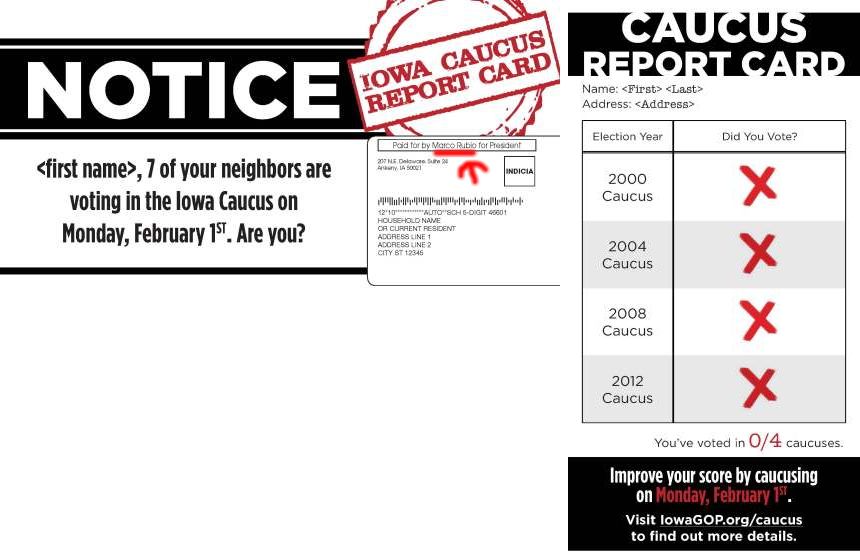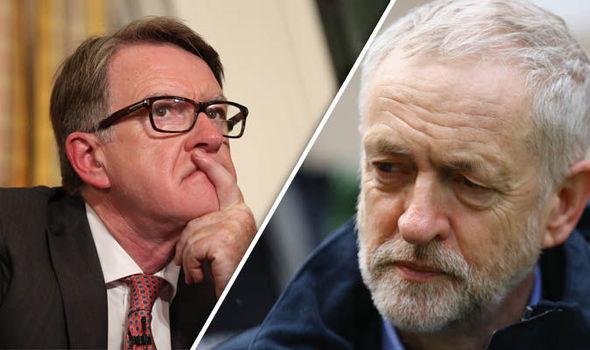
Over the weekend, Iowans began reporting receiving strange mailers from Ted Cruz’s presidential campaign. The mailings didn’t include any arguments for Cruz’s candidacy or attacks on his opponents. Instead, they included the recipient’s personal voting “score” (a percentage from 0 to 100) and “grade” (from A to F), as well as those for their neighbors. The yellow notices included a big red bar on top reading, “VOTING VIOLATION”:
Tom Hinkeldey, one of the recipients who tweeted a picture of a mailer Friday evening (since deleted because it included his address), told Independent Journal reporter Sarah Rumpf that it included a real list of his actual neighbors:
The Cruz campaign immediately confirmed that the fliers were real (though spokesperson Rick Tyler told Rumpf that the targeting was “very narrow”), and the candidate himself declared, “I will apologize to nobody for using every tool we can to encourage Iowa voters to come out and vote.”
Cruz’s opponents pounced immediately:
“Investigation” is a bit strong, but Iowa’s secretary of state, Paul Pate, did take to Facebook to say the mailer “misrepresents the role of my office, and worse, misrepresents Iowa election law. Accusing citizens of Iowa of a ‘voting violation’ based on Iowa Caucus participation, or lack thereof, is false representation of an official act”:
Statement from Secretary of State Paul Pate Regarding Misleading Mailer from Cruz for President CampaignDES MOINES – “…
Posted by Iowa Secretary of State Paul Pate on Saturday, January 30, 2016
He also noted that the mailer almost certainly does not represent actual Iowa caucus participation. “Caucuses are organized and directed by the state political parties, not the Secretary of State, nor local elections officials,” Pate writes, and as such the secretary of state does not maintain records on caucus participation.
It’s worse than that, actually. There’s some convincing evidence that the Cruz numbers aren’t based on people’s actual voting history at all, but were in fact entirely fabricated.
Iowa State University political scientist Dave Peterson told the New Yorker’s Ryan Lizza and Mother Jones’s Pema Levy that he and all his neighbors were given scores of 55 percent — even though he only moved to Iowa in 2009, and many of his neighbors were much older and have much longer voting records.
Peterson, for instance, has voted in the 2010, 2012, and 2014 general elections and in two of those primaries, which one would expect to yield a score of 5/6 or 83 percent — not 55. “The math simply doesn’t work,” he told Levy.
Lizza also reports that, “A source with access to the Iowa voter file told me that he checked several other names on Cruz mailers and that the voting histories of those individuals did not match the scores that the Cruz campaign assigned them in the mailer.” When Lizza contacted Cruz spokesperson Catherine Frazier, she “did not explain the methodology used, nor did she answer my question about whether the numbers were made up.”
Why would Cruz do this?
Cruz’s camp is quick to point out that it’s hardly the first to try this kind of tactic. Pate’s predecessor as secretary of state, Matt Schultz, said in a statement, “Our mailer was modeled after the very successful 2014 mailers that the Republican Party of Iowa distributed to motivate Republican voters to vote, and which helped elect numerous Republican candidates during that cycle.”
Marco Rubio’s campaign even sent a similar mailer based on past caucus participation, albeit not including neighbors’ records or accusing anyone of a “voting violation.” It also doesn’t resemble an official government mailing, based on the images obtained by Time reporter Zeke Miller:

Time / Zeke Miller, highly professional arrow pointing to Rubio’s name by Vox Both sides of the Rubio voting record mailer.
It’s not just a province of Republicans, either. MoveOn.org used a similar tactic to try to boost turnout for Barack Obama in the 2012 election:
Sample Voter Report Card-2 by Andy Kroll
All these tactics draw on a hugely influential 2008 study by political scientists Alan Gerber, Donald Green, and Christopher Larimer. In the summer of 2006, the researchers, with the help of political consultant Mark Grebner, sent about 80,000 households in Michigan different mailings encouraging them to vote; they specifically targeted households likely to vote in the Republican primary, which was contested.
About a quarter of the households in the study got a mailing emphasizing their civic duty to vote; another quarter got one telling them, “YOU ARE BEING STUDIED!”; the third group got a mailer listing the voting records of voters in that household; and the final group of 20,000 got one listing the household’s voting records and those of people living nearby.
Each of these treatments increased turnout, but the ones including past voting records were by far the most effective: Listing the household’s own voting record alone boosted turnout by 4.9 percentage points compared with households not getting mailings, and listing neighbors’ voting records too boosted turnout by 8.1 points.
“It is important to underscore the magnitude of these effects,” Gerber, Green, and Larimer write. “The 8.1 percentage-point effect is not only bigger than any mail effect gauged by a randomized experiment; it exceeds the effect of live phone calls and rivals the effect of face-to-face contact with canvassers conducting get-out-the-vote campaigns.”
Subsequent experiments by actual political practitioners confirmed the finding. “Political consultants, like Democrat Hal Malchow, found that similar letters in real elections could boost turnout by up to 2.5 percent,” the Washington Post’s Dave Weigel notes. And it inspired similar scholarly attempts to use mailers containing nonpartisan information to affect turnout, including a controversial study in 2014 in which Montana voters received fliers detailing the ideological leanings of their judicial candidates.
But Cruz’s execution left something to be desired. Larimer — one of the three political scientists behind the study — told Weigel, “The Cruz mailing is more negative than anything we have done and has the potential to elicit a negative response or what psychologists call ‘reactance’ or ‘boomerang effect.'”
That potential is already being realized. Tom Hinkeldey, one of the annoyed recipients of Cruz’s mailers, said that the experience tipped him over the edge. Now he’s caucusing for Rubio:
via : Vox – Policy & Politics


